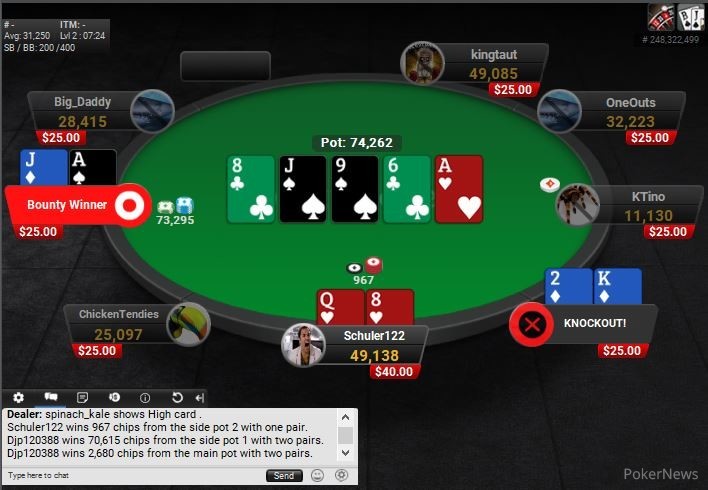Pot
It's one of the first things you learn when playing tournament poker: don't bet into a dry side-pot. People say that if you and an opponent see the flop when a third player is all-in, you shouldn't normally bet - because it's more important to eliminate the all-in player than win a few extra chips. This has become one a common fallacy in poker. Because Players B and C have bet more than player A can call, a side pot is created. The side pot is the amount that B and C bet that was not matched by A: $7 each for a total side pot of $14. The main pot is the money that was matched by all players who are still playing: $4 from A, $4 from B, and $4 from C, for a total main pot of $12. Only Players B or C may compete in the showdown for the side pot. What is a Side Pot in Online Poker? If you are new to poker, you might notice that in certain games and the players guide, there are 'side pots'. It is important to understand exactly what these side pots are and why they can be found in some games but not in others. One of Holdem Side Pot the most reliable and fun platforms, PlayAmo online casino offers its players all of Holdem Side Pot the best games, promotions, and benefits. Created by LawDude on August 5, 2009. A second pot created when a player goes all-in and additional bets are made. Only the players who are not all-in are eligible to win the side pot.
-1. The amount of money in the center of the table that stands to be won or lost on any given hand.
2. To wager an amount equal to the pot in a pot limit or no limit poker game.
A poker game is composed of an endless string of 'hands.' Each hand is a competition between players, who wager sums of money, called 'bets' in an attempt to win a larger sum of money called 'the pot.' As a hand progresses, all of the bets go into the pot, making it larger and more desirable. Additional cards come before each round of betting, often changing each player's probability of winning as well as their incentive to bet. If any player decides to put money into the pot, other players must either follow suit or throw their hands away. Each player acts in turn, and during each turn it is up to that player to make a value judgment about whether or not it is worth it to continue on in the hand. A player must consider how big the pot is, how much it costs to continue on in the hand, and what they expect their chances of winning are. If a player knows these three things with relative certainty, they can figure out whether it mathematically makes sense to continue, based upon the risk-reward scenario. This is called calculating 'pot odds.' If the player incorporates likely future events into the scenario, it is called calculating 'implied pot odds,' or simply 'implied odds' for short.
Ultimately, the goal in a poker game is to win money, not to win every single pot that is possible for you to win. Some players have a hard time making that distinction. There are many times when it is still possible for you to win the pot, but your chances of winning are so slim that it makes the bet too large and not worth calling. If you insist on calling in this spot, because of the law of averages, you will lose a substantial amount of money in the long run. So if you want to be a winning player, you have to decide prudently about whether or not it is worth it to call, and follow suit. This means that you will occasionally throw away a hand that would have ultimately won the pot. While this may feel bad when it happens, it is the correct way, and the only profitable way to play the game.

One of the ways that the betting can be structured in a poker game is call 'pot limit.' In this variation, players may bet up to the total amount in the pot when it is their turn to act. A slightly different structure variation is called 'no limit.' In a no limit game, players may bet up to the total amount of money that they have in front of them when it is their turn to act. In both of these games it is fairly common for players to bet the same amount as is in the pot. This is commonly called 'betting the pot,' or 'potting it.'
Usage: Pot And Repot, Pot It, Small Pot, Big Pot, Massive Pot
Previous Poker Term: Post
Next Poker Term: Pot Limit
How to Split Pots
On the surface, splitting pots is easy enough: simply take the pot, split it evenly, and each player takes their winnings. Foxwoods resort casino. Wall street poker rules.
This is especially easy when two players have the same five-card hand: each takes half. If it's three or four or more players all with the same hand, divide the pot by the number of players, and each player collects their winnings.
But things can get tricky fast.
High-Low
In high-low games, the easiest split pot is when one player wins the high and the other wins the low. Here, you simply divide by two and each player collects their winnings. A player with the best high and the best low hand 'scoops' the whole thing.

But, especially in games like Omaha High-Low, when lots of players might all have the same low or the same high, the pot needs to be split along more complicated lines.

One of the ways that the betting can be structured in a poker game is call 'pot limit.' In this variation, players may bet up to the total amount in the pot when it is their turn to act. A slightly different structure variation is called 'no limit.' In a no limit game, players may bet up to the total amount of money that they have in front of them when it is their turn to act. In both of these games it is fairly common for players to bet the same amount as is in the pot. This is commonly called 'betting the pot,' or 'potting it.'
Usage: Pot And Repot, Pot It, Small Pot, Big Pot, Massive Pot
Previous Poker Term: Post
Next Poker Term: Pot Limit
How to Split Pots
On the surface, splitting pots is easy enough: simply take the pot, split it evenly, and each player takes their winnings. Foxwoods resort casino. Wall street poker rules.
This is especially easy when two players have the same five-card hand: each takes half. If it's three or four or more players all with the same hand, divide the pot by the number of players, and each player collects their winnings.
But things can get tricky fast.
High-Low
In high-low games, the easiest split pot is when one player wins the high and the other wins the low. Here, you simply divide by two and each player collects their winnings. A player with the best high and the best low hand 'scoops' the whole thing.
But, especially in games like Omaha High-Low, when lots of players might all have the same low or the same high, the pot needs to be split along more complicated lines.
For instance, more than one player might all have the same low hand--this is easy enough if a board contains lots of low cards. On the other hand, multiple players might share the same high--for example, they are all able to make the same straight.
In these cases, the easiest way to manage the pot is to first split it in two: one high pot and one low pot. Then, the players who share the same high divvy up the high pot, and the players with the same low divvy up the low pot. (This is the same way you would divvy up a pot in a game like Chicago: split the pot in two, with one half going to the player with the high spade in the hole, and the other half going to the player with the best five-card hand--and yes, sometimes those halves get scooped by the same player!)
Poker Online Side Potion
The most common example of this is quartering: two players have the same low hand, but one has a better high hand. So they split the low, and one player takes the high, so that one player gets 75% of the whole pot and the other gets 25%--a quarter. But it's not uncommon for three or more players to play for the same high or low, so players might get one sixth or one eighth or an even smaller fraction of the pot, while one player ends up take two-thirds of five eights for themselves.
Sidepots
Poker Pot Crossword
When one player is all in, they can win the main pot: the pot that every active player can theoretically win. But other players can continue betting amongst each other by placing their chips into a side pot: a pot that only some active players can win. And yes, sometimes the side pots can get even bigger than the main one!
On the surface, side pots are relatively simple: the main pot usually gets stacked near the player who is all in, and the other two players can bet into the side pot. But, when multiple players are all in, there might be more than one side pot: for instance, a player is blinded all in, another player goes all in on the flop, and other players continue betting through the river and turn. Imagine what can happen if there are three or four or more players all in at the same time, with side pots stacked all around the table, while two big stacks keep betting into one another--complicated enough at a Texas Hold'Em table, and even more so at a High-Low game, where all those pots could get split up even more!
Poker Side Pot Rules
In these cases, the key is remembering who can win each pot. At casinos, this is simple enough, since the dealer sorts out each pot. But at home games, it's crucial to remember who can win each pot: every player can win the main pot, including the player who went all in first; then the next side pot can be won by everyone who could match the next all-in bet; and so on and so on. If it sounds complicated, don't be afraid to take extra steps to sort it out--if you play a lot of Omaha High-Low, you might consider keeping a pad and paper at the table!